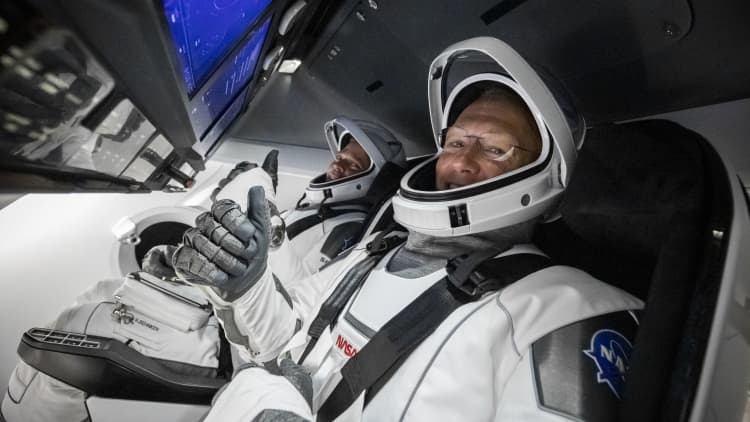Boeing’s Starliner spacecraft atop the United Launch Alliance Atlas V rocket rolls out in Florida on Thursday, May 30, 2024.
Isaac Watson | NASA
Boeing’s first Starliner flight with astronauts on board was called off in the final minutes on Saturday, and the backup Sunday launch date was also canceled.
The company was targeting a June 1 launch at 12:25 p.m. ET of its capsule, which would have carried astronauts to the International Space Station for the first time in a final major test of the system.
Leaders from Boeing, NASA and the United Launch Alliance, or ULA, held a press conference later Saturday afternoon to provide updates on the malfunction and the status of the next launch attempt.
“The disappointment lasts for about three seconds,” said Mark Nappi, Vice President and Program Manager of Boeing’s Commercial Crew Program. “And then you just immediately get busy and do your job.”
Boeing had a backup launch date scheduled for Sunday at 12:03 p.m. EDT. But Saturday evening, NASA announced the cancellation of that Sunday launch “to give the team additional time to assess a ground support equipment issue” at the Florida launch site.
NASA plans to provide further updates on the next steps for the rocket launch. The following possible launch dates are June 5th or June 6th.
An investigation into the cause of the malfunction is underway and crew members may have to work through the night to troubleshoot the issue.
“The leading suspect would be either a hardware problem or a problem with the network,” ULA CEO Tory Bruno said at the Saturday press conference, noting that they will not fully know the source of the issue until the investigation is complete.
The launch’s hold was automatically issued earlier Saturday for an unspecified reason, NASA said on its broadcast, with under four minutes remaining in the countdown. Holds in a rocket launch countdown â as well as “scrubs,” indicating a launch delay â are a common occurrence in the industry. The crew on board are safe and will disembark.
Two NASA astronauts are aboard the Starliner capsule, which would be carried by United Launch Alliance’s Atlas V rocket to the International Space Station.
NASA and Boeing called off a launch attempt in early May due to an issue detected with the rocket. ULA, a joint venture of Boeing and Lockheed Martin, replaced the rocket’s problematic valve.
After calling off the May attempt, NASA and Boeing found a “small” helium leak in Starliner, causing the agency and company to perform another series of assessments. After analysis, NASA and Boeing believe the source of the leak is in the spacecraft’s helium propulsion system. But officials said last week that the leak is “stable” and “not a safety of flight issue.”
Starliner’s crew debut has been delayed by years, with SpaceX’s competing Dragon capsule flying astronauts for NASA regularly since 2020 under the agency’s Commercial Crew program. To date, Boeing has eaten $1.5 billion in costs due to Starliner setbacks and nearly $5 billion of NASA development funds.
The spacecraft was once seen as a competitor to SpaceX’s Dragon. However, various setbacks and delays have steadily slipped Starliner into a backup position for NASA, with the agency taking the rare step of reassigning astronauts off the first Boeing crew flights in 2021. Boeing is under contract to fly six operational Starliner missions to the ISS. Saturday’s crew flight test represents the final major step before receiving NASA certification to begin regular missions.
The astronauts
NASA astronauts Butch Wilmore, left, and Suni Williams.
Credit: Kim Shiflett | NASA
Butch Wilmore and Suni Williams are flying on Starliner, with the former serving as the spacecraft’s commander and the latter as its pilot.
Wilmore joined NASA in 2000 and has flown to space twice previously on the Space Shuttle and Russia’s Soyuz. Before NASA, Wilmore was a U.S. Navy pilot.
Williams was selected by NASA in 1998 and has also flown to space twice before, on the Space Shuttle and then the Soyuz. Like Wilmore, Williams was a Navy pilot before joining the space agency.
The rocket and capsule
Boeing’s Starliner spacecraft atop the United Launch Alliance Atlas V rocket is seen on the launch pad of Space Launch Complex-41 at Cape Canaveral Space Force Station in Florida on Thursday, May 30, 2024.
Isaac Watson | NASA
Starliner launches on ULA’s Atlas V. The rocket debuted in 2002, and the Starliner crew flight test represents its 100th launch.
The capsule is built to carry as many as four NASA astronauts per flight and more than 200 pounds of research and cargo. The spacecraft lands using a parachute and airbag system. Starliner is reusable, and each capsule is designed to fly as many as 10 missions.
The mission
Boeing’s crew flight test aims to certify the Starliner system as capable of carrying NASA astronauts to and from the ISS.
If Starliner launches on Saturday, it will fly in space for about 25 hours before a planned docking with the International Space Station at 1:50 p.m. on Sunday. The astronauts will then spend about a week on the ISS, focused on testing Starliner, before returning to Earth.

â CNBC’s Rebecca Picciotto contributed to this report.
Read the original article here
